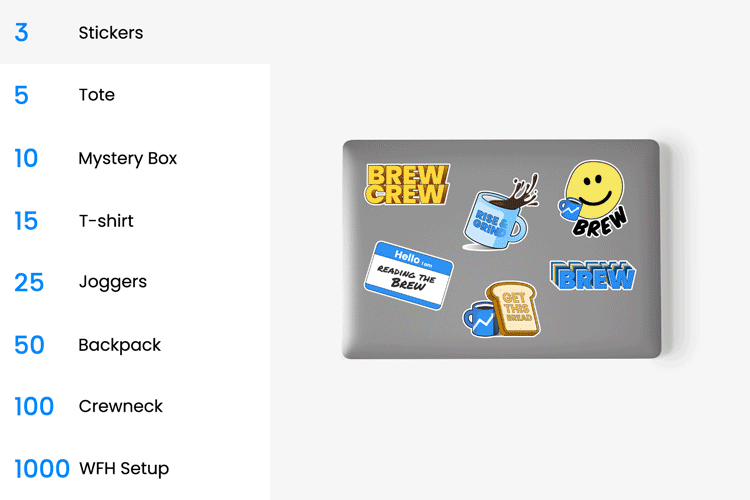It’s Monday, and the tear-jerking marketing rush ahead of the holidays is in full swing. Exhibit A: Apple’s annual holiday film featuring stop-motion art, a grumpy boss, and, of course, iPhones.
In today’s edition:
—Alyssa Meyers, Ryan Barwick, Erin Cabrey
|
|
Angela Ruggiero
When she was a professional hockey player, data and analytics were a big part of Angela Ruggiero’s life: monitoring her heart rate, measuring fluid intake, and searching for ways to perform better on the ice. When she joined the business world—with three degrees and four Olympic medals in hand—she quickly realized that not everyone operated like she did.
“Big decisions are being made with very little data, very little insight,” Ruggiero told Marketing Brew. “It always seemed really fast and loose, like, ‘Oh yeah, we’ve always worked with that vendor. Oh, that’s just how we do it…’ It just seemed kind of archaic.”
That realization inspired Ruggiero to co-found Sports Innovation Lab, a market research company focused on providing fan intelligence data and strategic advisory services to clients that have included leagues like the LPGA, NFL, NHL, and WNBA, as well as brands like Google, Nike, and Coca-Cola. Fan data still isn’t the easiest sell, Ruggiero acknowledged, but she anticipates it’ll become increasingly important over the next few years, especially in the growing world of women’s sports.
On the ice: Ruggiero first started playing hockey with her dad and her siblings when she was seven. Her sister stopped playing after a couple of years, leaving her as the only girl in California in her age division. She loved the sport, so she played on boys’ teams, which resulted in “a lot of adversity,” she said. Luckily, she added, “The boys on my team were always super supportive, including my brother.”
Ruggiero said she imagined she would grow up to play for the LA Kings, the NHL team based in Los Angeles. Instead, as a senior in high school, she was selected to compete on the first-ever US women’s Olympic ice-hockey team as its youngest member. After the team won a gold medal in Nagano, Japan, in 1998, Ruggiero went on to play and study at Harvard, where she got a bachelor of arts in government, and, later, an MBA from Harvard Business School. She also has a master’s in sports management from the University of Minnesota.
“I always knew I was going to have a second career after hockey,” she said.
This story is the second in a series on women leaders working to increase brand investment in women’s sports. Continue reading this profile here, and stay tuned for more.—AM
|
|
So your brand has started working with influencers to boost revenue. Love it! But you’re not sure how the heck to measure and track that revenue.
It’s a common problem, and impact.com wants to help solve it by understanding why tracking influencer performance is a pain and how brands are overcoming those challenges. And if you’re willing to share your thoughts, you’ll be entered for a chance to win a $200 gift card.
With so many touchpoints and marketing channels in the customer journey, it’s hard to determine exactly how influencers contribute to revenue. On top of that, many brands are still using manual, time-consuming tracking methods or software with limited tracking capabilities.
From different KPIs for different kinds of partners to real-time data insights and monitoring, impact.com wants to know how your org tracks partnership performance—and how those processes can improve.
Enter to win a $200 gift card just for responding.
|
|
Illustration: Dianna “Mick” McDougall, Photo: Google
Google wants advertisers and publishers alike to buy into its plans for an open internet after the third-party cookie is phased out, setting up consortiums and working groups to give major stakeholders a front-row seat.
But one group designed to help publishers navigate new adtech tools and better monetize their sites is facing an uncertain future after several major publishers, including News Corp. and USA Today, have been shown the door.
Rob Beeler, a publishing consultant and a former digital ad executive who said he was brought on by Google in 2021 to lead the group, told Marketing Brew that last month the tech giant suggested it would no longer participate in a consortium of publishers first convened to help understand Google’s Privacy Sandbox, its alternative to the third-party cookie.
- The group, called the Publisher Council, has at times included major publishers like the Washington Post, the New York Times, Fox News, Disney, Paramount, Hearst, and Condé Nast, as well as some publishing platforms.
Google’s Publisher Council, which had been convening monthly, functioned as a two-way street between the tech giant and the group’s members to understand the business implications of its Privacy Sandbox, explained Paul Bannister, the chief strategy officer at the publisher platform Raptive, which is part of the council.
“The way I view it, it was a place for Google to get direct access to a large group of publishers, to gather feedback about Privacy Sandbox, to share information about Privacy Sandbox, and ultimately, to try to encourage publishers to adopt it, to get it into their business planning and engineering roadmaps,” he told Marketing Brew.
Beeler said the council was a place for open discussion and provided an opportunity for many publishers to get significant facetime between themselves and Google. Publishers have previously shared concerns about Privacy Sandbox with Marketing Brew, including the fact that the shift could be costly.
Last month, though, Beeler said he gave an ultimatum to representatives from USA Today, the Daily Mail, and News Corp., whose US publications include the Wall Street Journal, MarketWatch, and Barron’s: leave the council, or the Publisher Council will be dissolved.
“It was either the group continues, or it doesn’t,” Beeler told Marketing Brew.
Keep reading here.—RB
|
|
Busà Photography/Getty Images
The retail media network boom over the past few years has seen nearly every major multi-brand retailer sell digital advertising opportunities to CPGs online. Now, retailers are starting to explore the potential of another major ad space: physical stores.
US digital retail media ad spending is projected to hit $61 billion next year, per Insider Intelligence, while in-store retail media spending is only a couple hundred million dollar market, Andrew Lipsman, principal analyst at Insider Intelligence, told Retail Brew.
But brick-and-mortar stores have the potential to bring in high-margin supplementary revenue streams for retailers, and more eyes for CPG brands, Lipsman noted.
- In-store audiences are on average 70% larger than digital ones, per Placer.ai and Comscore data.
- In November 2022, Walmart’s monthly reach was 212.6 million in-person shoppers compared to 144.9 million online shoppers, while Kroger’s 32.4 million monthly online shoppers was just a third of its brick-and-mortar reach.
A number of retailers like Walmart, Kroger, and Hy-Vee have announced moves to cash in on in-store media with screens across stores displaying third-party ads. More are likely to follow, as physical stores are a “natural evolution,” from online advertising, according to Lipsman, who called stores the “next major media channel.” While there are plenty of opportunities for eye-catching innovation from entrance to checkout, bringing retail media networks in stores also comes with challenges.
Keep reading on Retail Brew.—EC
|
|
|
You’ll like the sound of this. Audio advertising is one of the most effective marketing channels. So why is it so underrepped in media plans? Check out Audacy’s State of Audio 2023 report, a playbook packed with planning tips, creative how-tos, and innovative trends to help advertisers level up their audio possibilities. Take a look.
|
|
Level up your career with these resources from our sponsors!
|
|
Morning Brew
There are a lot of bad marketing tips out there. These aren’t those.
Top secret: How one cybersecurity CMO approaches marketing to small- and medium-sized businesses.
Fledgling: Marketing lessons for startups, from the co-founder of a payment management company.
Take notes: Top marketing goals from executives, plus tips on actually achieving them.
Retail read: Explore the impact of AI on customer experience and online sales this holiday season! Dive into Retail Brew’s article for essential insights that can accelerate your retail marketing strategy.
Always be building: Resilient, successful brands have one thing in common—they invest in themselves, even in turbulent times. Hear brand-strengthening tips from 450 CMOs in Frontify’s new report. Download it here.* *A message from our sponsor.
|
|
Francis Scialabba
Executive moves across the industry.
-
Michael Minter, formerly global head of marketing at DC Shoes, is joining apparel brand Reef as the brand’s first-ever CMO.
- Adriana Germilli has been hired as VP of marketing at DavidsTea, where she was previously director of marketing until 2022.
-
Laurence Lapierre, Burberry’s director of marketing and communications, is leaving to join PR firm KCD Paris as SVP, media relations.
|
|
ADVERTISE
//
CAREERS
//
SHOP
//
FAQ
Update your email preferences or unsubscribe
here.
View our privacy policy
here.
Copyright ©
2023
Morning Brew. All rights reserved.
22 W 19th St, 4th Floor, New York, NY 10011
|
|











